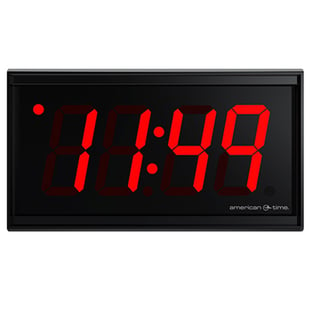
Often in life, your decisions come down to two options. White or wheat toast. Grilled or fried chicken. Take the blue pill or the red pill — any Matrix fans out there?
You have a similar choice when choosing the display format for your facility’s synchronized time system — digital or analog.
While analog clocks have their place, there are times when digital is clearly the better choice. Here, we'll explore the advantages you'll enjoy with digital clocks and what you'll need to consider.
Better Readability
If your top priority is to quickly and easily read the clock, you're going to want the bright glow of digital. Think about the size of the room — larger spaces will benefit from digital clocks. A gym, auditorium or large open room or building layout is likely better served by a digital clock since it can be read at a glance from a long distance. For example, a model with 4-inch digits can be read from 250 feet away.
Functional in Low Light
If you're getting clocks for a room that is often dark, such as an auditorium or lecture hall where the lights are regularly dimmed, it makes more sense to install digital clocks. Plus, if the lights are going down, it's likely you don't want people looking at their phones. With digital clocks, your audience can keep track of the time when the lights go out and their phones are stashed away.
Quicker and More Accurate
If you're just glancing at an analog clock, you're really just getting an estimate on the time. Often, that's all you need, but there are cases in which people have to tell the time down to the second, and, do it in an instant. Test-takers in pressure-packed classrooms would likely appreciate how much easier a digital clock would make tracking the time they have left to complete an exam. In a manufacturing setting, businesses with time-sensitive production processes also stand to benefit, as would doctors in an exam or operating room.
 More Features
More Features
Digital clocks come with more features than their analog counterparts. Digital clocks provide superior readability during tense, time-sensitive scenarios, and some digital models can help people track the time with the help of a countdown timer. They can help to get students to their next classroom on time. Medical staff can rely on the countdown timer during medical procedures. Manufacturing facilities can track tasks, activities, and efficiency by using a countdown timer, as well.
Digital or Analog?
Digital clocks are clearly easier to read and have more robust features than analog clocks, but they're generally more expensive. Ensure that you consider your budget when deciding between digital or analog clocks. Your budget may not be affected much when buying one or a few replacement digital clocks, but if you're replacing a whole system, the additional cost adds up.
Aesthetics
Digital clocks are great for a variety of reasons, but they don't offer the classic look of an analog clock. There's an undeniable appeal of a round clock with ticking hands that give a room an added touch of elegance. Note the difference between an e-reader and an actual book. Undoubtedly, the e-reader has impressive technology features, is lighter to hold, and offers a library of reading options in one package, but some still prefer turning real pages in a book.
Whether you want a variety of technology features, or if you prefer a classic clock, the choice is up to you. No matter which style of clock you choose — digital or analog style — it's important to weigh the pros and cons of each. Only then can you make the best decision for your location.



